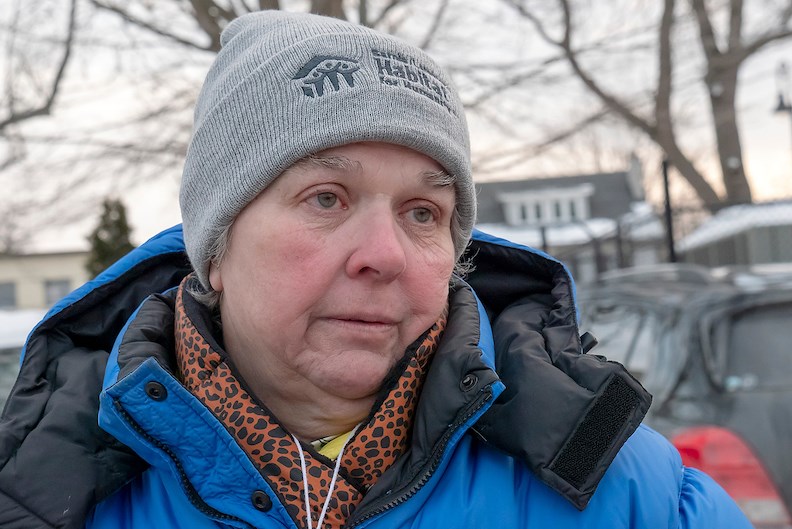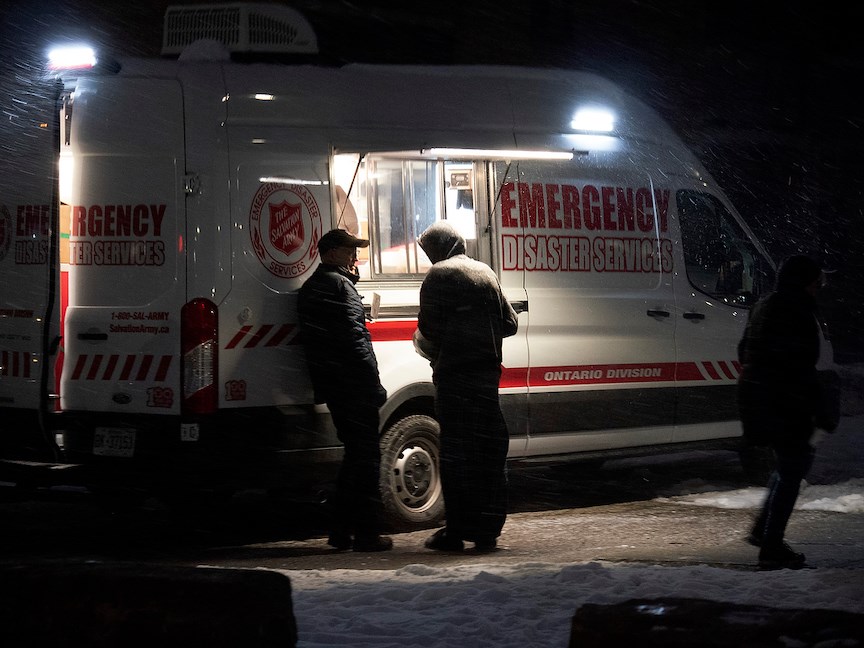The Journal's Cathy Dobson and photographer Glenn Ogilvie talked to some of Sarnia’s homeless population over the course of several months in order to tell their stories. In this five-part series appearing each day this week, learn about who the homeless are and what they experience. Cathy Dobson
It’s one of those bone-chilling winter nights in Sarnia when the temperature dips down to -15 C and the snow squeaks underfoot.
In a downtown parking lot behind the public library, several volunteers arrive first, dressed in heavy coats, woolly hats and warm mitts to ward off the cold. They begin unloading donations from their cars.
Soon hungry folks of all ages come on foot, some alone, many with a friend. There’s a stark difference in how they’re dressed. Thin jackets and bare hands are the norm.

A number of donated winter coats have been dropped off near a table set up to serve hot beverages. One slight man, possibly in his 50s, quietly asks if it’s okay to take one.
The answer is always yes. Those coats are particularly needed this night. A few numbing minutes in the cold can cause frostbite. The man immediately pulls one on over his sweater.
People keep arriving, lining up for a hot meal and a friendly smile. For more than a year, they’ve been able to count on the Salvation Army truck to arrive twice a week and dish out food, hand out toilet paper, winter clothing, Gatorade, hot chocolate or whatever else has been donated.
They are among the growing number of local residents who are either homeless or precariously close to being homeless. On this particular night, about 50 come by. They greet some of the volunteers by name and visit briefly before disappearing into the night.
Often they don’t have a bed waiting for them in one of the city’s shelters, either because the shelters are full or they’ve been kicked out for breaking the rules.
Lambton County Social Services estimate there are 200 -250 in Sarnia-Lambton without stable housing. They sleep in shelters or on a friend’s couch. If they have government assistance, they might have a place but it’s so expensive they can’t afford food. For many, renting an apartment is temporary because issues like mental health, addiction or just plain bad luck come up and they find themselves back on the street.
Housing officials say that on any given night, anywhere from 10-50 sleep rough in Sarnia – in the doorway of a public building, under a tarp, or in the bushes along the city’s nature trails.
It’s being called an unprecedented emergency, exacerbated by the pandemic.
They are hidden in plain view. Once you know where to look, it is obvious. But it’s not safe for them to divulge their favourite spots.
The volunteers and the professionals doing outreach for the homeless in Sarnia know where to find them or where to leave food and warm clothing for the most desperate who won’t try to get a shelter bed or line up at a food truck.
"Everyone counts and everyone matters in this community."
The Salvation Army began regular delivery of hot meals to Sarnia’s homeless in 2021.
About seven months ago, Margaret Capes of the Community Law School voluntarily joined the effort. She created a group of volunteers that shows up with the food truck to help however they can. Lambton County provides a harm reduction nurse to hand out clean needles and and provide referrals for follow up care, especially for those who won’t go to the ER.

They are busy. People without proper housing have a lot of needs, not least of which is socialization. There’s a lot of friendly chatter and hugs at these events behind the library. The mood is upbeat even though the circumstances are usually gut-wrenching.
People are mostly congenial as they sort through boxes of books provided by Literacy Lambton and Capes’ volunteers. Inside each book is a piece of paper with information about the Good Samaritan Act that explains if someone is overdosing, you can help them, call the police and not necessarily get charged.
“The whole idea is to reconnect with people who are feeling very disconnected,” said Capes. “It’s not about trying to meet a government mandate. It’s just about making people feel like they are more connected.
“Everyone counts and everyone matters in this community. If someone is living on the margins, we need to help them.”
On the coldest days Capes distributes outreach bags – she calls them survival kits – to the homeless who are so disenfranchised they won’t go to the truck or a soup kitchen for food. The bags are made up at the Salvation Army with donations of socks, drinks and food. Capes takes them to the detached souls in our city, dropping them along the Howard Watson Trail, in certain city parks and in places along London Road.

They are for people who don’t want to be found but will pick up the bags when no one is looking.
Capes knows where they are because she’s seen the plywood enclosures and the small groups of tents. She also sees the tracks in the snow.
“Everyone has a different story,” she said. “That’s the thing that drives me a little bit crazy. People who are living precariously get painted with the same brush, they all have addiction problems or they all have mental health problems...No, if you talk to each individual person, they all have their own stories.
“I’ve seen every age group too. Fifteen, 16-year-olds to 70-year-olds. The younger ones are often addicts. The women are sometimes victims of abuse. I hear all sorts of things.”
Daphne Bourque of community and family services with the Salvation Army, ensures the food truck arrives with hot meals for as many as 100 homeless or near-homeless every Tuesday and Thursday night.
The truck, its staff and volunteers serve the bulk of their meals behind the downtown library, a place chosen for being central to Sarnia’s homeless population. They also go twice a week to The Chipican Motel in the city’s north end. Its 22 units are full of people who would likely be homeless if they weren’t spending their Ontario Works or Ontario Disability Support cheques to pay rent there.

“These folks at the Chipican are really friendly,” says Bourque. “We feel like we know them. It’s like going to a cul-de-sac party. It’s a consistent group and we’ve walked through many situations with them. We’ve seen their kids take their first steps. We’ve seen people pass away.”
Those living at The Chipican are doing relatively well, she said. If it weren’t for The Chipican, their situation could be much worse.
“Several of them are stuck. They don’t know where they fit. They wouldn’t work well with roommates but there’s no way they can afford an apartment on their own,” Bourque said.
A young woman of about 20 comes up while we’re talking and wraps her arms around Bourque. “How are you, sweetie? Are you okay,” Bourque asks.
“I’m alright,” says the young woman. “I’ve got new clothes. See my new shoes. My new friend is taking me to the mall for a phone tonight. He knew I’ve been homeless and he’s been good to me and gave me a place to stay.”
“Well, you know where to find me, right, if you need me,” replies Bourque.
Sarnia has always had a homeless population. It’s just much larger and looks different than it did pre-pandemic, she said.
“People used to couch surf but now people are less likely to let people in their homes. And with the cost of everything being so high, they don’t always have the generosity they did in the past.
“I think the pandemic also caused a lot of substance abuse issues.”
Bourque has worked with the Salvation Army for 16 years and said some of the people she sees in the parking lot have been on the street for a long time.
“But many of them are new.”
NEXT: Part 2 of Stories from the Street. Profiles of Sarnia’s homeless.

